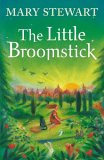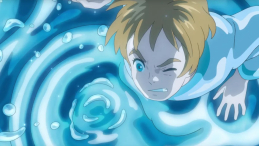The Little Broomstick: The Movie Wasn’t Faithful, and That’s a Good Thing
 The Little Broomstick by Mary Stewart
The Little Broomstick by Mary Stewart
My rating: 4 of 5 stars
I kept trying to write a review of this book as a book by itself, but my feelings for the movie kept interfering with my opinions for the book, so I’m going to instead do a comparison of book to movie.
Oh, and, uh… SPOILERS FOR BOTH BOOK AND MOVIE.
You have been warned.
How did I first decide to read this book?
Well, that is because I first watched the movie that was inspired by this book: Mary and the Witch’s Flower.
[image error]
And the reason I watched that movie is because I am a longtime fan of Studio Ghibli (yes, that Ghibli!) and Mary and the Witch’s Flower was produced by Studio Ponoc, which is kind of the baby of Studio Ghibli–a lot of Ghibli alumnae went and formed Ponoc as their own thing. Apparently Mary and the Witch’s Flower even received Miyazaki’s personal seal of approval!
Video credit Tokyosaurus
Okay, okay. I’ll stop babbling about the background behind how the movie got made and instead do a direct comparison. Let’s start at
THE BEGINNING!
The beginning of Mary and the Witch’s Flower gives us a thrilling action scene of a girl we assume is Mary (spoiler alert: it’s not Mary) running away on her broom, and we assume she’s a thief:
In contrast, The Little Broomstick starts as all other classics do: infodumping who the main character is, why she’s staying at her great-aunt’s house, etc. Definitely not as exciting.
The movie definitely makes a bigger deal out of the flowers (after all, it is called “the witch’s flower”) but even though the book is called “the little broomstick,” the little broomstick gets way more attention in the movie. Poor broomstick. In contrast, Mary’s family and reason for staying with her great-aunt is given a lot more attention in the book.
After that, the story proceeds pretty much identically in both mediums: Mary is bored, wants to do something to help around the house, gets in the way, meets Tib the cat, finds the flower and the broomstick, and gets kidnapped by said broomstick to Endor College, a magical academy accessible only through magical means.
[image error]
Then we hit the part of the book I really liked more than the movie. In both book and movie, Mary meets Mr. Flanagan, the broomkeeper, meets Ms. Mumblechook, the headmistress, and passes herself off as a new student.
Watching the movie, however, little old Aspie me didn’t understand the unspoken bit where Mary heard about the rule that dictated trespassers on college property would be transformed. Whereas in the book, this is made quite clear by Mary’s internal monologue: Mary pretends to be a new student so that she’s not a “trespasser.” Similarly, when Ms. Mumblechook is giving her the tour of the school, I much preferred the book version. In the movie, Mary is a “prodigy” because she’s got red hair. That’s it. In the book, Mary isn’t treated like a prodigy, but rather Ms. Mumblechook is trying to figure out what classes Mary should be enrolled in and misunderstands pretty much everything Mary tells her so that in her eyes, Mary is a great witch. Which I much preferred, because that was one of those moments where you’d need to have read the book to understand that otherwise glaring plot hole.
[image error]
Then Mary gets the grand tour, steals a spellbook of master spells, and gets on her broomstick to go home. Here’s another point where the book did much better. In the movie, Ms. Mumblechook learns about the flower, and Mary claims that it belongs to Peter, the vicar’s son, to whom she delivered a jar of raspberry jam that morning. Ms. Mumblechook then learns Peter’s address from a note that Mary unwillingly gives her. But in the book, Mary hasn’t even met Peter yet, and Ms. Mumblechook tells Mary that most students make donations to the school, and in time, Mary will also understand and make a donation, as well. When Mary is taken into the invisibility class, Tib is included in the invisibility spell, and even after the spell is dissolved, Tib is still invisible. Then she sets off to go home, and only after she gets home does she discover that Ms. Mumblechook has kidnapped Tib.
[image error]
At this point in the book, I wondered if Peter was just a film-only character who didn’t have any sort of part in the book, only to find a few pages later that oh, here’s Peter! He apparently wandered through the mist looking for Gib (the other cat who hangs out with Tib) and ended up at Dr. Dee’s mansion.
Now here’s where things got a bit confusing for me. In the movie, Mary tells her broomstick to “go back” and it takes her to a little house a ways away from the College. There, she discovers that the broomstick belonged to none other than her own Great-Aunt Charlotte, who, out of all the book characters, encountered the most changes between book and screen. In the book, Great-Aunt Charlotte was an elderly deaf lady who is barely developed enough to serve as a plot device: nothing more than a reason for Mary to interact with a new town and go on her adventure. In the movie, Great-Aunt Charlotte is a more developed character, taking part in various plot events and coming into play as to the reason why (spoiler redacted).
[image error]
Then Mary and Peter return to the stronghold, free the other animals using the spell book, and Peter volunteers to stay behind, etc. The movie was definitely more action-packed, with an epic conclusion featuring a blue slime monster reminiscent of those found in the Haruhi franchise.
 [image error]
[image error]
Spoiler alert: there’s no blue monster in the book, and Peter isn’t put through a horrendous experiment to try and fuse his DNA with that of the flower. In the book, the conclusion is more of a chase scene between Mary and Peter and Madam Mumblechook and Dr. Dee.
I much preferred the movie ending over the book. The book ending felt too rushed; the first half was a very slow build-up, but then the second half was “The cat’s been kidnapped! Mary goes off to save him. Mary found Peter at Dr. Dee’s cottage! They rescued the animals from the stronghold and now are heading home together on the broomstick. But Madam Mumblechook is chasing after them! Oh, look, they’ve found a way to escape!”
(spoiler alert) It’s not stated outright that Peter and Mary killed her, but in the book, Madam Mumblechook crashes into a lake and doesn’t resurface. The kids essentially killed an ancient witch and are totally blase about it. Yeah, that’ll cause no psychological harm in the future to remember how you killed an older lady! xD
In the movie, Madam Mumblechook lives, but she just recognizes the error of her ways after her entire plan is foiled and it’s implied that she’ll be better from this point on.
[image error]
I must say that subtlety went directly out the window with Studio Ponoc. They made a film with a clear plot, a clear character arc for Mary, and a clear message inspired by the 2011 Great East Japan Earthquake: if humans rely too much on technology and nuclear power, it will backfire on them. But the movie also had its flaws that didn’t exist in the book (for example, the broomstick not obeying Mary occasionally even when she was under the effects of the fly-by-nights)
I can’t even think of what the theme of the book would have been. After returning from their grand adventure, Mary and Peter just sort of forget it ever happened. Or at least that’s what’s implied. What did they learn? What did we learn? What did Stewart want to say with her book? True, TLB is a fun read, especially if you’re looking for something a bit whimsical in the style of Peter Pan, but I like books that leave you with some sort of statement after the fact. I’d put it on my bookshelf right next to books like The Hobbit, (ironically, since I organize my bookshelf by author last name, The Little Broomstick and The Hobbit are essentially right next to each other anyway xD) but I much preferred the movie, which knew what it wanted to do and what kind of message it wanted to send, and did just that, even if it was a bit overstated by the end. The Little Broomstick is a fun, whimsical read that does what it wants to do but yet leaves you wanting more. If I were to have told this story, I would have combined a few choice elements of the book (ex. the reason Madam Mumblechook misunderstood everything Mary said) with the general idea of how the movie went about it. I much prefer the movie in this sense, but there are too many plot holes in the movie for me to completely disregard the book, which was a great story in its own way.
Anyway, I recommend both book and movie in this case, as long as you understand that this story is essentially “in name only.” MatWF takes the basic premise of the book–girl moves to the countryside with her great-aunt, finds a magic broomstick that whisks her off to Endor College, and sets out on an adventure to save a cat, and tells it in a different format with a different message. If you want a whimsical adventure reminiscent of The Hobbit, pick up the book. If you want an action-packed more serious tale akin to Lord of the Rings (Actually, Lord of the Rings and MatWF have the same theme!) watch the movie. But definitely read the source material if you watch the movie, and definitely watch the movie if you read the book!
If you’d like to pick up a copy for yourself, you can buy The Little Broomstick on Amazon, grab Mary and the Witch’s Flower on Blu-ray and DVD, and follow Mary Stewart on Goodreads!
If you liked this post and want to support my content:
Follow me on Twitter, where I’m most active
Subscribe to my Youtube channel, where I talk about more books than just one per week!
Follow my blog (click on that little blue box to the right that says “Follow The Discerning Reader”) to get updates in your inbox every time I post!
Make it a good week, everyone, and I’ll see you next Sunday!
Corinne 乙女



